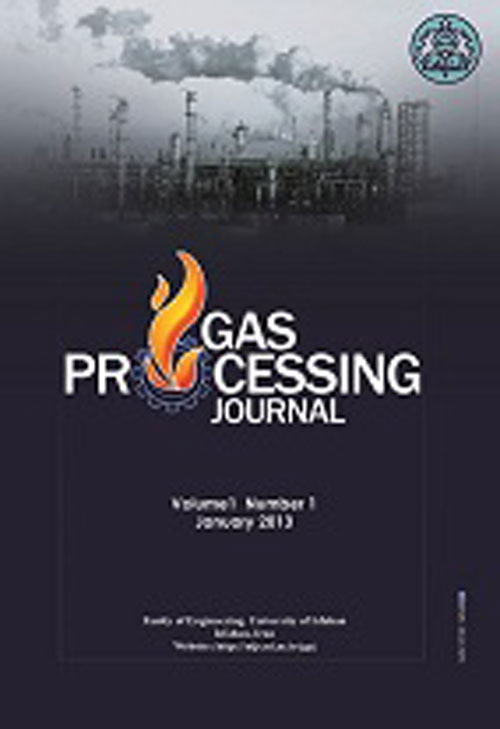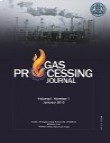فهرست مطالب

Gas Processing Journal
Volume:9 Issue: 2, Summer 2021
- تاریخ انتشار: 1400/11/03
- تعداد عناوین: 8
-
-
Pages 1-14Cogeneration energy systems are one of the most promising clean, efficient technologies for satisfying industrial energy needs. In this study, a cogeneration system consisting of a solid oxide fuel cell, a gasification unit, a gas turbine cycle, and a steam network module is proposed. This topping system is integrated with a steam network that provides steam for different utilities by recovering steam. Also, biomass –as renewable energy– is used to address the problems of fossil fuels, such as scarcity of resources and environmental issues. The system is evaluated from an energy perspective to ascertain the feasibility of the system. Based on the results, the efficiency attained from this system is 54.35%. An optimization study based on a genetic algorithm is performed to find the best conditions, which indicates an efficiency improvement to 65.06%. Moreover, a parametric study on different steam network pressure levels is taken place, which shows the importance of the VHP header on system performance.Keywords: Cogeneration, Steam network, SOFC, Biomass, Gasification, gas turbine
-
Pages 15-32One of the most important petrochemical processes is olefin production, and the most important part of this process is the thermal cracking furnace. The analysis of the flow and combustion process in these furnaces is important. In this research, combustion analysis in these furnaces has been investigated by examining two case studies of thermal cracking furnaces. The governing equations of the problem process, including mass and momentum and energy equations, along with combustion equations, are solved in CFX software. Temperature profiles are obtained at different points. The heat flux is obtained at different heights of the furnace. The hot spots obtained on the reactor as well as the simulation of the conversion of raw materials into products during the reactor are based on the simulation of the furnace by placing burners on the floor of the furnace (Ilam Petrochemical Olefin).Then, for the second case study, including the placement of burners in the floor and wall of the furnace (Maroon Petrochemical Olefin Furnace), thermal failure simulation has been performed. Next, optimization of combustion and reduction of Nox pollution by the re-burning method has been done. Thermal flux is decreasing at height of more than 3 m in the furnace, which can be offset by mounting low-power burners on the wall. The excess air ratio at 1.15-0.85 has shown the best mode of reducing Nox production in the burning method.Keywords: Numerical Simulation, Furnace, Reactor, Thermal Cracking, Olefin, re-burning
-
Pages 33-42The present study seeks to conduct the optimization of a heavy-duty diesel engine under RCCI combustion fueled with diesel fuel and natural gas enriched with hydrogen. Since NOx emission is one of the most important concerns of using hydrogen as a sole fuel or an additive to hydrocarbon fuels in an internal combustion engine like RCCI engine, thus, the main goals of this study are to overcome the NOx challenge, enhance the RCCI combustion characteristics, and reduce the fuel consumption when the conventional hydrocarbon fuels are substituted with hydrogen. In order to conduct the optimization process, an artificial neural network coupled with the design of the experiment concept was employed to identify the RCCI combustion mathematical model and provide the required population for two optimization algorithms, namely genetic algorithm, and particle swarm optimization algorithm. The results from the optimization process show that by advancing the diesel fuel injection along with the appropriate amount of exhaust gas recirculation and nitrogen as diluents, the level of EURO VI for NOx can be met. However, the losses in the RCCI engine output power is less than 5% meanwhile the gross indicated efficiency is over 50% and the reduction in hydrocarbon fuels consumption is about 40%.Keywords: RCCI combustion, Heavy-Duty Diesel Engine, Hydrogen, artificial neural network, Optimization
-
Pages 43-52
When the oil well pressure diminishes, production in the stock tank will decrease. One of the best methods for enhancing the production rate is an artificial gas lift. Injecting gas reduces the density of the oil column, resulting in a bottom-hole pressure. As a result, the oil comes to the surface more easily, increasing production. Accordingly, in this paper, we designed an artificial gas lift for a well in one of the south Iranian oil fields in a new method. We also carefully examined the effective parameters of oil production rate, including gas injection rate, injection depth, tubing diameter, gas specific gravity and temperature and pressure of injected gas, and water cuts. Then, to optimize the process under study, we determined the best value for each of these parameters, while studies do not optimize all parameters. Injection gas rate and pressure had an optimum point; the tubing diameter at one point had the highest output. As the specific gravity of the injection gas increased, production generally decreased. As the temperature of the injection gas rose, diminished decreased slightly. To ensure the correctness of the work, the analysis of the necessary sensitivities about the optimal effect of each parameter has been done with sufficient accuracy. The results show that gas injection will lead to a 156.4% increase in production in the reservoir which is a remarkable and thought-provoking result.
Keywords: Pressure, Specific Gravity, Temperature, Tubing Diameter -
Pages 53-60
Gas refinery is an important process in point of energy production and economics. The importance of gas refinery and high amounts of inputs and emissions in the processes emphasize the studying the environmental burdens. The environmental impacts of the natural gas refinery process were evaluated in a gate-to-gate life cycle assessment study based on CML-IA baseline model. Eleven environmental indicators of 1-tonne output gas were calculated and then normalized in SimaPro Software. The values of intermediate indicators of abiotic depletion, fossil abiotic depletion, global warming, ozone layer depletion, human ecotoxicity, freshwater ecotoxicity, marine water ecotoxicity, terrestrial ecotoxicity, photochemical oxidation, acidification potential, and eutrophication were 2.25×10-6 kg Sb eq, 140700.40 MJ, 6846.57 kg CO2 eq, 4.30 kg CFC-11 eq ×10-8, 28.34 1,4-DB eq, 0. 13 Kg 1,4-DB eq, 0752.85 kg 1,4-DB eq, 7.91 kg 1,4-DB eq, 0.40 kg C2H4 eq, 10.27 kg SO2 eq, and 2.68 kg PO4 eq, respectively. The greatest indicator was fossil abiotic depletion with a value of 4.47×10-9 and global warming (1.36×10-9). Acidification potential (3.65×10-10), eutrophication (2.03×10-10), and terrestrial ecotoxicity (1.63×10-10) indicators were ranked after those and the ozone layer depletion indicator had the lowest value. The refinery process, electricity, electronics devices, amine, sodium sulfite, steel, and copper inputs were the main factors affected by most of the studied environmental indicators. The life cycle assessment as a reliable method can be applied in gas refinery sector to address, evaluate, and then decrease the environmental burdens.
Keywords: Natural gas, Refinery, Pollution, Environmental impact assessment, Life cycle, CLMbaseline -
Pages 61-82
Today, for enhancing the trend of energy demand in the world, the use of energy by the approach of maximizing the efficiency of energy systems is inevitable. On the other hand, the high growth rate of unmanned aerial vehicles (UAV), governments investment to develop the necessary infrastructures for the progress of this technology, the variety of applications, and the advantages, indicate its special role in the future. In the present study, an integrated system consisting of PEM electrolyzer, PEM fuel cell, photovoltaic panel, and hydrogen and oxygen storage tanks is developed as a UAV propulsion system so that it can provide the required power. The power required by the UAV was supplied by the PEM fuel cell of the system. The intended hydrogen and oxygen are provided through a hydrogen and oxygen storage tank. In this condition, the capacity of the tanks is known as the limiting factor during the UAV flight time. For more flight continuity, part of the consumable hydrogen and oxygen during the flight is regenerated by installing a photovoltaic panel, using solar renewable energy and also PEM electrolyzer. The hydrogen and oxygen generated by the electrolyzer is 49.04% of the PEM fuel cell consumption, indicating that the UAV flight continuity using the integrated structure of the present study can be increased up to approximately 1.5 times. Then, by performing a parametric study and changing the main parameters of the system, including current densities of PEM electrolyzer and PEM fuel cell, as well as temperature and solar radiation level, the integrated system is evaluated in different conditions and the results are reported. Finally, by examining various aspects of the present plan, including the weight conditions, the efficiency of the integrated system developed in the present study as a new propulsion system for UAVs with various purposes has been specified.
Keywords: PEM fuel cell, Solar photovoltaic panel, PEM electrolyzer, Unmanned aerial vehicle -
Pages 83-102
Given the importance of using hydrogen fuel as one of the best sustainable energy sources, different hydrogen liquefaction technologies are developed to store and transport it over long distances. Process integration with other cycles and new high-efficiency liquefaction cycles can make hydrogen fuel more economically viable, especially for liquid hydrogen exporter countries like Iran. In this study, a hydrogen liquefaction cycle with a capacity of 1.5 tons per day is integrated with a liquefied natural gas (LNG) production process. Energy, exergy, and economic analyses are implemented to examine the proposed cycle. The novelty of this paper is based on two points: first, simultaneous production of liquefied hydrogen (LH2) and LNG in one process with an innovative configuration that leads to better performance compared to that of similar cycles, and second, simultaneous use of two-equation of states (EOS) for pure hydrogen and mixed refrigerant streams. Process integration of the LNG system with the hydrogen liquefaction unit reduces the capital expenditures (CAPEX) and operating expenses (OPEX) for both systems. Components with the greatest exergy destruction are identified. The coefficient of performance (COP) and the figure of merit (FOM) are 0.89 and 0.72, respectively. Specific energy consumption (SEC) of the proposed cycle is 5.31 kWh kg^(-1), +25 % more efficient than the similar hydrogen liquefaction cycle in the literature. The annual total cost for the proposed cycle is $35.6 million, including CAPEX, OPEX, and operation and maintenance expenditures (O&M).
Keywords: Energy Analysis, Economic Analysis, Process integration, Efficiency, ExergyAnalysis, Hydrogen -
Pages 103-112
In this paper, a theoretical analysis was carried out for optimum designing of the leading edge of centrifugal compressor blades. The effect of change in specific heat capacity ratio on the optimal design of impeller blades' leading edge was investigated theoretically considering the inlet pre-whirl. It was found that with the growth in heat capacity ratio, the maximum achievable mass flow function was reduced, while the optimum blade angle at the leading edge was increased. Results showed that the maximum achievable mass flow function for γ = 1.13, was about 0.77 and occurred at a pre-whirl angle (α) of 60.3° and blade angle (β) of 48.2°. For γ = 1.4, the maximum achievable mass flow function was about 0.64 and occurred at α=59°, β=51°. For the case of γ = 1.67, the maximum mass flow function was obtained at about 0.55 and took place at α=57.9°, β=52.7°. It was found that there is a limitation for the hub to shroud radius ratio in impeller designing. The interval between hub to shroud radius is reduced by increasing the angle of inlet guide vanes.
Keywords: Centrifugal compressor, Heat capacity ratio, Optimum inlet, Inlet guide vanes, Mach number


